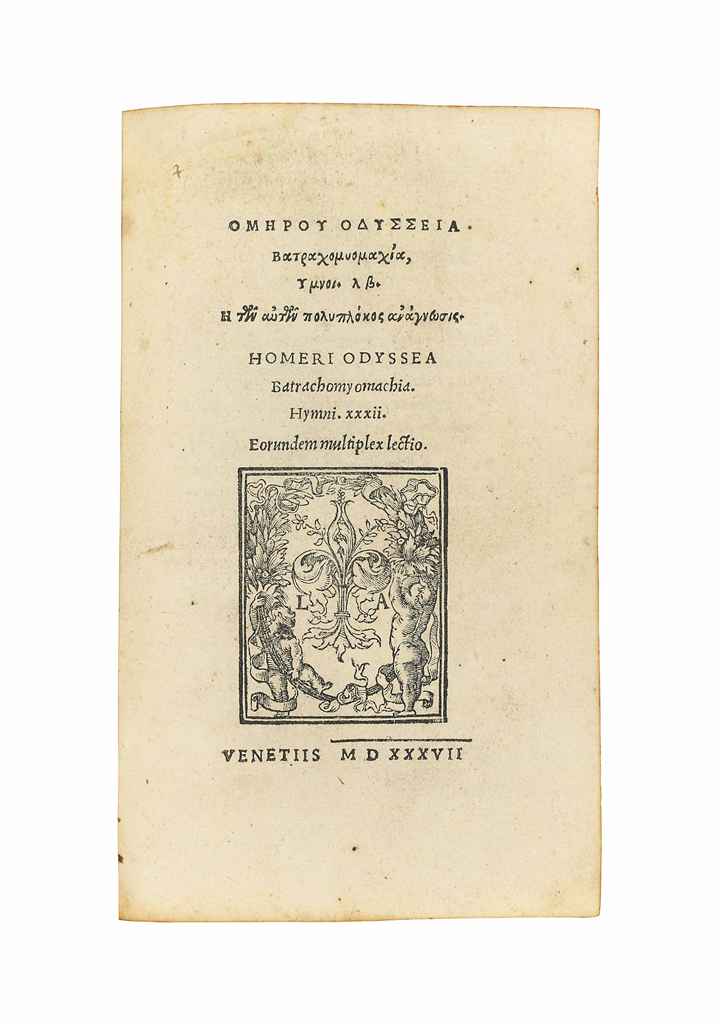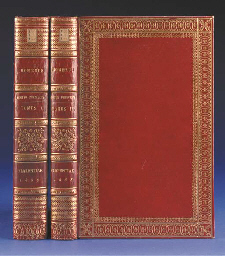HOMER (?8th century B.C.). Opera , in Greek. Edited by Demetrius Chalcondylas. Florence: [Printer of Virgil (C 6061), perhaps Bartolommeo di Libri, and] Demetrius Damilas for Bernardus and Nerius Nerlius (with the financial support of Giovanni Acciaiuoli), 9 December 1488 [but not published before 13 January 1488/89, date of the dedication]. Median 2° (324 x 230/220mm), 2 volumes. Collation: [volume I:] & #960;A-D 8 E 10 (A1r Bernardo Nerli's dedicatory letter to Piero de' Medici in Latin, A1v editor's preface in Greek, A3r Herodotus's life of Homer, B1r Plutarch's life of Homer, E7v Dio Cassius's oration on Homer, E9v-10 blank); A-Z ET 8 (Iliad). 249 leaves (of 250; without blank E10). [Volume II:] AA-ZZ 8 ETET 6 (AA1r Odyssey, XX2r Batrachomyomachia, XX6r Hymns to Apollo, ETET5v colophon in Greek, ETET6 blank). 189 leaves (of 190; without final blank). A single paper stock (crown watermark). Types: text 121Gk (recast by Damilas on a larger body, with the addition of a few sorts, from the same matrices as Paravisinus type 1:117 Gk), dedication 96R (Di Libri type 1), signatures 110R (Printer of Benignus type 1). 39 lines. 10- and 2-line spaces for initials. (Vol. I is 10 mm wider than vol. II, slight foxing in extreme margins.) VERY FINE LATE-18TH-CENTURY VIENNESE ROCOCO BINDING BY G.F. KRAUS (binder's ticket), gold-tooled red straight-grained morocco, dentelle border on sides composed of flowers, foliage, stars, roundels and other small tools, surrounding a shaped panel containing central ornament of the same tools, spines with raised bands tooled in compartments, gilt edges, turn-ins and green silk liners gold-tooled with floral rolls. Provenance : Vienna, Imperial Library, sold as a duplicate (inscription); Sir Mark Masterman Sykes (Evans sale, 20 May 1824, lot 1523, 43 gns. to Pickering); Beriah Botfield, who had Bartolozzi's stipple engraving after John Brown of Homer's bust (published by Mrs. Brown in 1788) inserted at the beginning of volume I. EDITIO PRINCEPS of all texts, with the exception of \kBatrakomyomakia\K, which was printed earlier in a Greek-Latin edition (see note to lot 37). THE MOST IMPORTANT FIRST EDITION IN GREEK CLASSICAL LITERATURE, in bibliophile condition and with a distinguished provenance. Earlier castings of Homer type, the design of which may have been modelled on Michael Apostolis's script (see Barker, Greek Script & Type p. 28-31), had been used by Damilas and Paravisinus for Lascaris's Ερώτηματα (Milan: 1476), the first book printed entirely in Greek, and by Bonus Accursius for his first editions of Aesop and Crastonus (see lots 37 and 40, respectively). For the complications in trying to find an existing Florentine printing shop, which Damilas and the Nerli brothers might have employed for their Homer -- the most ambitious Greek production until the Aldine Aristotle -- see Proctor ( Printing of Greek p. 66-69) and R. Ridolfi ( La Stampa in Firenze nel secolo XV ch. 7). In his preface Chalcondylas describes the corrupt state of the manuscripts used for the texts of Homeric Hymns and Batrachomyomachia . Copy-text for the epics was more adequate and he adds that in order to decide corrections of uncertain readings he worked his way through Eusthatius's monumental 12-century commentary. SIGNED BINDINGS BY KRAUS OR KRAUSS ARE OF THE GREATEST RARITY. HCR 8772; BMC VI, 678 (IB. 27657 and 27657a-c); Goff H-300; IGI 4795; CIBN H-173; Flodr, Homerus 1; PMM 31. Botfield 180-82.
HOMER (?8th century B.C.). Opera , in Greek. Edited by Demetrius Chalcondylas. Florence: [Printer of Virgil (C 6061), perhaps Bartolommeo di Libri, and] Demetrius Damilas for Bernardus and Nerius Nerlius (with the financial support of Giovanni Acciaiuoli), 9 December 1488 [but not published before 13 January 1488/89, date of the dedication]. Median 2° (324 x 230/220mm), 2 volumes. Collation: [volume I:] & #960;A-D 8 E 10 (A1r Bernardo Nerli's dedicatory letter to Piero de' Medici in Latin, A1v editor's preface in Greek, A3r Herodotus's life of Homer, B1r Plutarch's life of Homer, E7v Dio Cassius's oration on Homer, E9v-10 blank); A-Z ET 8 (Iliad). 249 leaves (of 250; without blank E10). [Volume II:] AA-ZZ 8 ETET 6 (AA1r Odyssey, XX2r Batrachomyomachia, XX6r Hymns to Apollo, ETET5v colophon in Greek, ETET6 blank). 189 leaves (of 190; without final blank). A single paper stock (crown watermark). Types: text 121Gk (recast by Damilas on a larger body, with the addition of a few sorts, from the same matrices as Paravisinus type 1:117 Gk), dedication 96R (Di Libri type 1), signatures 110R (Printer of Benignus type 1). 39 lines. 10- and 2-line spaces for initials. (Vol. I is 10 mm wider than vol. II, slight foxing in extreme margins.) VERY FINE LATE-18TH-CENTURY VIENNESE ROCOCO BINDING BY G.F. KRAUS (binder's ticket), gold-tooled red straight-grained morocco, dentelle border on sides composed of flowers, foliage, stars, roundels and other small tools, surrounding a shaped panel containing central ornament of the same tools, spines with raised bands tooled in compartments, gilt edges, turn-ins and green silk liners gold-tooled with floral rolls. Provenance : Vienna, Imperial Library, sold as a duplicate (inscription); Sir Mark Masterman Sykes (Evans sale, 20 May 1824, lot 1523, 43 gns. to Pickering); Beriah Botfield, who had Bartolozzi's stipple engraving after John Brown of Homer's bust (published by Mrs. Brown in 1788) inserted at the beginning of volume I. EDITIO PRINCEPS of all texts, with the exception of \kBatrakomyomakia\K, which was printed earlier in a Greek-Latin edition (see note to lot 37). THE MOST IMPORTANT FIRST EDITION IN GREEK CLASSICAL LITERATURE, in bibliophile condition and with a distinguished provenance. Earlier castings of Homer type, the design of which may have been modelled on Michael Apostolis's script (see Barker, Greek Script & Type p. 28-31), had been used by Damilas and Paravisinus for Lascaris's Ερώτηματα (Milan: 1476), the first book printed entirely in Greek, and by Bonus Accursius for his first editions of Aesop and Crastonus (see lots 37 and 40, respectively). For the complications in trying to find an existing Florentine printing shop, which Damilas and the Nerli brothers might have employed for their Homer -- the most ambitious Greek production until the Aldine Aristotle -- see Proctor ( Printing of Greek p. 66-69) and R. Ridolfi ( La Stampa in Firenze nel secolo XV ch. 7). In his preface Chalcondylas describes the corrupt state of the manuscripts used for the texts of Homeric Hymns and Batrachomyomachia . Copy-text for the epics was more adequate and he adds that in order to decide corrections of uncertain readings he worked his way through Eusthatius's monumental 12-century commentary. SIGNED BINDINGS BY KRAUS OR KRAUSS ARE OF THE GREATEST RARITY. HCR 8772; BMC VI, 678 (IB. 27657 and 27657a-c); Goff H-300; IGI 4795; CIBN H-173; Flodr, Homerus 1; PMM 31. Botfield 180-82.















Try LotSearch and its premium features for 7 days - without any costs!
Be notified automatically about new items in upcoming auctions.
Create an alert